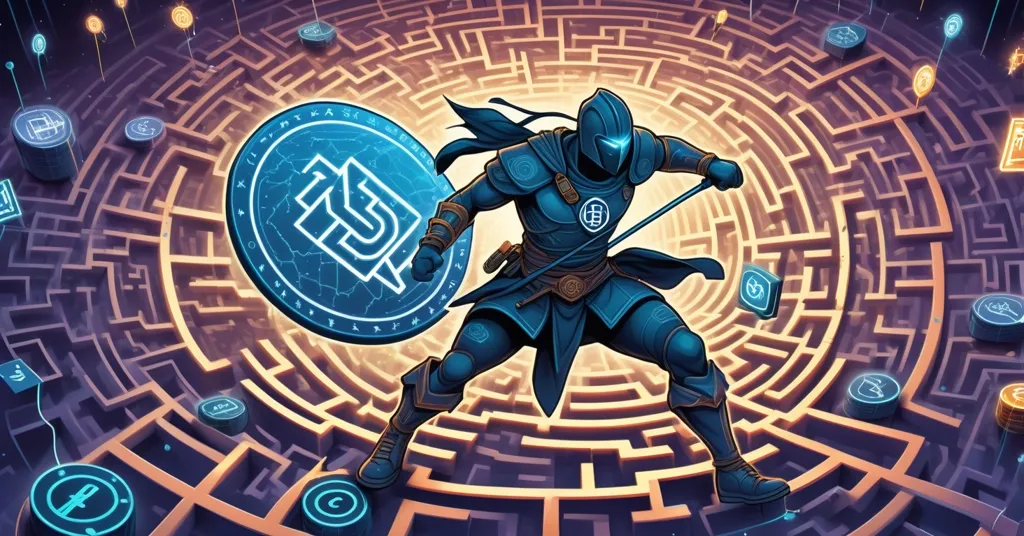Transak Secures 6 New U.S. State Licenses to Boost Stablecoin Access Amid Regulatory Chaos

Transak Pushes Stablecoin Access with 6 New U.S. State Licenses Amid Regulatory Quicksand
Transak, a leading firm in stablecoin payments and fiat-to-crypto conversions, has secured Money Transmitter Licenses (MTLs) in six additional U.S. states—Iowa, Kansas, Michigan, South Carolina, Vermont, and Pennsylvania. This brings their direct operational footprint to 10 states, a notable step in their quest to streamline digital asset transactions across a frustratingly fragmented U.S. regulatory landscape.
- New Milestone: Transak now holds MTLs in 10 states with 6 new additions.
- Ambitious Target: Direct licensing in all 50 states within 12-18 months.
- Regulatory Hell: U.S. state-by-state rules remain a brutal barrier compared to unified systems like the EU’s MiCA.
- Stablecoin Surge: Growing transaction volumes highlight their role in reshaping global finance.
Transak’s Licensing Breakthrough: Expanding Stablecoin Reach
With the addition of these six states, Transak’s direct licensing now covers 10 U.S. regions, including earlier wins in Arkansas, Delaware, Illinois, Missouri, and their inaugural license in Alabama secured earlier in 2024. This is no small feat in a country where each state operates as its own regulatory fiefdom. The company has 19 more MTL applications pending and is gunning for full nationwide coverage within the next 12 to 18 months. While partnerships currently allow Transak to serve users in 46 states, their shift to a fully compliant, direct network shows a commitment to playing by the rules—even if those rules are a labyrinthine mess. For more on their expansion, check out the detailed report on Transak’s stablecoin payment growth across new U.S. states.
For the uninitiated, stablecoins are digital currencies pegged to stable assets like the U.S. dollar, designed to hold steady at roughly $1 each. Think of them as digital dollars on a blockchain, avoiding the wild price swings of something like Bitcoin. Transak’s focus is on fiat-to-crypto on-ramps—services that let everyday folks convert dollars into digital assets straight from a bank account or card. Imagine a Michigan resident who couldn’t easily buy stablecoins last year; now, with Transak’s new license, they can fund a wallet in minutes to dive into DeFi investments or send money across borders without hefty fees.
Bryan Keane, Transak’s compliance officer for the Americas, summed up the mission with clarity:
“Every new license we secure brings us closer to a future where users can move between fiat and digital assets seamlessly and lawfully.”
But let’s not kid ourselves—getting there is like navigating a minefield blindfolded. The impact of these licenses varies by state due to unique local laws. For instance, Pennsylvania has historically been tough on crypto firms with strict bonding requirements, while Vermont has leaned into blockchain-friendly policies. Transaction fees and limits may also differ compared to states where Transak operates via partners, though exact figures remain under wraps for now. Still, for users in places like Iowa or Kansas, this could mean faster, more direct access to stablecoin services without third-party middlemen skimming off the top.
The U.S. Regulatory Quagmire: A Compliance Clusterfuck
The U.S. regulatory environment for crypto is less a framework and more a 50-piece puzzle with half the pieces missing and the rest actively trying to stab you. Unlike the European Union’s Markets in Crypto-Assets (MiCA) framework, where a single authorization unlocks operations across 27 countries, American firms like Transak must battle state-by-state for MTLs. These licenses are mandatory for money transmission and digital asset management, often requiring registration with the Financial Crimes Enforcement Network (FinCEN) as a Money Services Business (MSB), plus adherence to Anti-Money Laundering (AML) and Know Your Customer (KYC) protocols. It’s a costly, time-sucking slog that can drain resources faster than a Bitcoin miner burns electricity.
Historically, this isn’t new—early Bitcoin exchanges like Mt. Gox faced similar state-level hurdles before federal scrutiny even kicked in. Today, while federal stablecoin legislation remains a distant fantasy, companies are stuck playing whack-a-mole with local laws. Keane himself hinted at the grind:
“Any framework that defines how regulated stablecoins can be issued, held, and used is a net positive.”
Translation: even a half-baked rulebook is better than this gridlock. But here’s a devil’s advocate take—why is Transak grinding through this regulatory quicksand when markets like the EU offer a saner path? Sure, the U.S. is a juggernaut of economic opportunity, but at what cost when you’re buried in paperwork instead of building the next killer app? On the flip side, this fragmentation might be a twisted blessing. It forces firms to build ironclad compliance systems, potentially future-proofing them for when Washington finally wakes up. Heck, it could even foster decentralization by preventing an overreaching federal policy that smothers innovation with a one-size-fits-all hammer. Call it regulatory Darwinism—only the toughest survive.
Stablecoins Reshaping Finance: Beyond Crypto Hype
Zooming out, stablecoins aren’t just a crypto nerd’s toy—they’re handling trillions in transactions annually and rewriting global finance. Federal Reserve Governor Stephen Miran dropped a bombshell on November 7, pointing out that stablecoins are juicing demand for U.S. Treasuries and could drag down long-term interest rates. That’s not small potatoes; it’s a macroeconomic shift with tentacles reaching far beyond blockchain forums.
Stablecoins are also the lifeblood of Decentralized Finance (DeFi)—think of DeFi as a bank without a building, where smart contracts on blockchains like Ethereum let you lend, borrow, or earn interest directly with crypto. They’re a lifeline for remittances too, especially in unbanked regions where traditional wire transfers cost an arm and a leg. But let’s not drink the Kool-Aid uncritically. Stablecoins aren’t bulletproof—depegging events, like past wobbles with Tether (USDT), show they can lose their $1 anchor under stress. Regulatory crackdowns on issuers like Circle or Tether loom large as well, a reminder that “stable” doesn’t mean “safe.”
Transak’s licensing push ties directly into this bigger picture. Their work isn’t just about dotting i’s and crossing t’s—it’s about positioning stablecoins as a bridge between dusty old fiat systems and the blockchain future. Industry efforts like the Blockchain Payments Consortium, uniting heavyweights such as Fireblocks, Polygon Labs, Solana Foundation, and Stellar Development Foundation, hammer this home. They’re standardizing cross-chain stablecoin transactions, representing over $10 trillion in annual volume. That’s a neon sign flashing “maturity” for blockchain tech integrating with traditional finance. Meanwhile, in Southeast Asia, Bitget Wallet’s QR-based stablecoin payments via VietQR and Solana Pay in Singapore show digital assets creeping into everyday purchases—coffee with crypto, anyone?
Innovation Amid Red Tape: Transak’s Tech Edge
Transak isn’t just playing defense with licenses; they’re pushing offense with tech. In August 2025, they became the first crypto on-ramp to support wire transfers, letting users fund wallets straight from their banks. They’re also prepping Automated Clearing House (ACH) payments—think of ACH as the backbone of direct deposits or bill payments in the U.S. Integrating it means buying crypto could soon feel as mundane as paying rent. These aren’t just bells and whistles; they’re bets on making stablecoins a no-brainer for the average Joe.
But there’s a catch. Wire transfers and ACH open doors to fraud vulnerabilities or bank resistance—some financial institutions still treat crypto like a contagious disease. Compared to competitors like MoonPay or Ramp Network, who are also racing to lower fiat-to-crypto friction, Transak’s state-by-state licensing grind seems uniquely masochistic. MoonPay, for instance, often leans on global partnerships over direct U.S. compliance. Whether Transak’s approach pays off or becomes a costly detour remains to be seen.
A Bitcoin Maximalist Lens: Stablecoins as a Stepping Stone
From a Bitcoin maximalist perch, stablecoins are a useful but temporary crutch. They grease the wheels for adoption, acting as a gateway for normies to eventually stack sats. But in a truly decentralized future, fiat pegs could become relics—why tether to a dying dollar system when Bitcoin’s hardness as money stands unmatched? Still, let’s give credit where it’s due: stablecoins fill niches Bitcoin doesn’t touch, like microtransactions or DeFi yield plays, and Transak’s efforts indirectly boost BTC by normalizing crypto on-ramps. It’s not the endgame, but it’s a damn good opening move.
Navigating the Future: Will the U.S. Catch Up?
Transak’s dogged pursuit of licensing is commendable, but it’s also a glaring spotlight on how far behind the U.S. lags in crafting a coherent crypto policy. Every MTL is a victory, yet it underscores the absurdity of a system where innovation plays second fiddle to bureaucratic inertia. Washington’s dithering on stablecoin laws isn’t just annoying—it’s damn near sabotage of a financial revolution. Will regulators finally get their act together, or will pioneers like Transak keep footing the bill for this disarray? That’s the trillion-dollar question hanging over the blockchain space.
Key Takeaways and Burning Questions on Transak’s Stablecoin Push
- What do Transak’s new U.S. state licenses mean for stablecoin access?
They expand direct stablecoin and fiat-to-crypto services to 10 states, offering users in places like Iowa and Pennsylvania faster, compliant transactions as Transak eyes nationwide coverage. - Why is U.S. crypto regulation such a nightmare for firms like Transak?
A fragmented state-by-state licensing system piles on costly compliance burdens, unlike the EU’s streamlined MiCA framework, slowing innovation with endless red tape. - How are stablecoins influencing global finance beyond crypto markets?
Moving trillions yearly, they’re boosting U.S. Treasury demand and could lower interest rates, signaling a macroeconomic shift as noted by Federal Reserve insights. - What’s the importance of groups like the Blockchain Payments Consortium?
This alliance standardizes cross-chain stablecoin transactions for over $10 trillion in volume, paving the way for seamless, globally compliant blockchain payments. - How is Transak advancing fiat-to-crypto tech amid regulatory chaos?
By pioneering wire transfers and prepping ACH payments, they’re making crypto purchases as easy as everyday banking, though risks like fraud or bank pushback linger. - Is the U.S. market worth the headache for crypto innovators?
Despite the regulatory disarray, the U.S.’s economic clout makes it unavoidable; enduring the pain could position Transak as a leader if federal clarity ever emerges.


